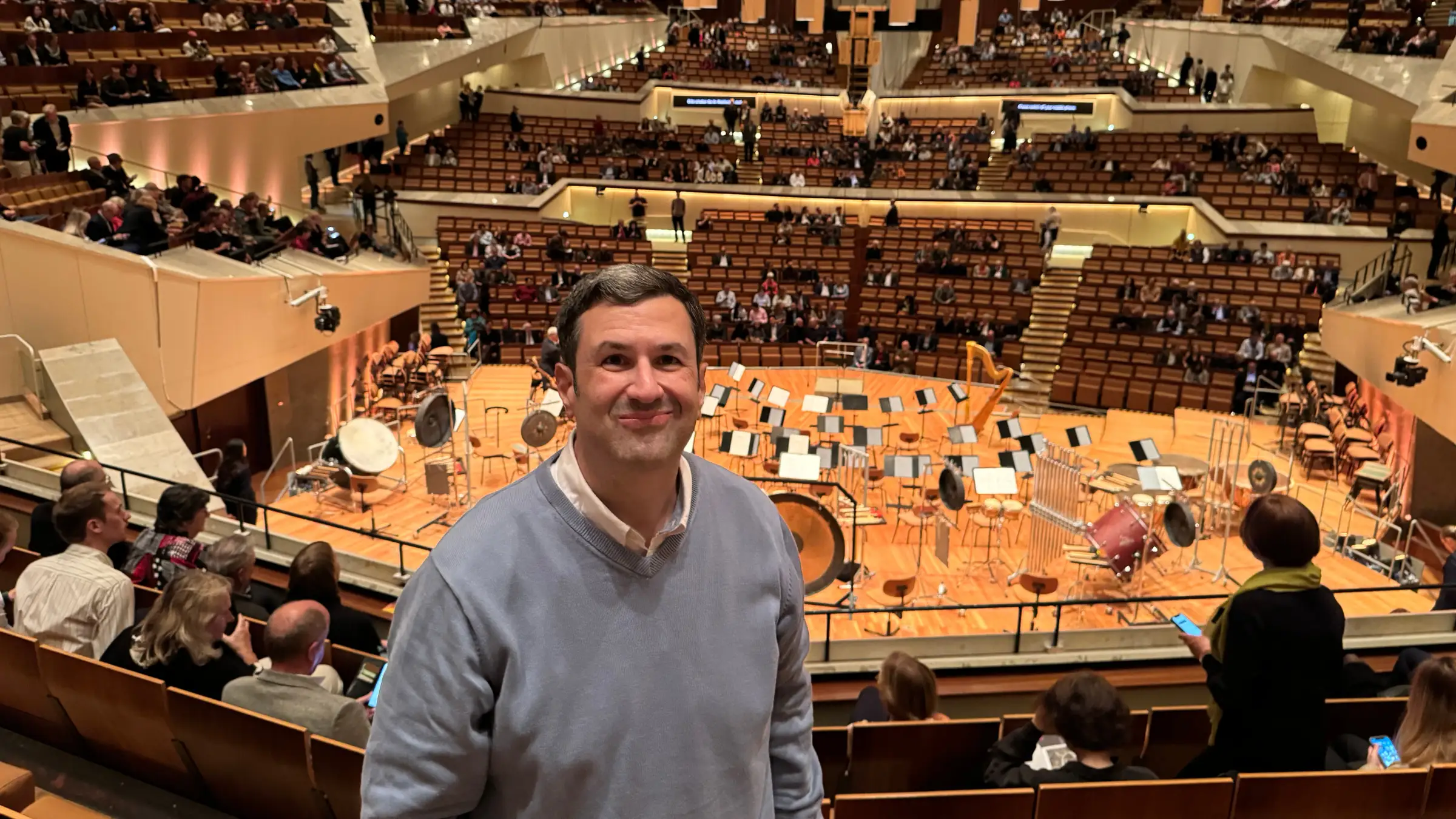Orchestra conductors are always facing the music — literally, not metaphorically — which means they never face me. Name any other profession where keeping your back turned to your customers is not considered rude.1
After who-knows-how-many classical concerts, I have finally seen what the front side of conducting looks like. It gave me a new perspective on music — literally and metaphorically.
Here’s what happened and what I saw:
On a trip to Berlin a few weeks ago, I saw the Berlin Philharmonic play. The concert hall is oddly shaped,2 and while most of the audience faces the stage, some seating sections wrap around the sides and back. I bought seat 14 in row 5 in block H — not only an affordable seat at €50 but one that would afford me a direct view of Chief Conductor Kirill Petrenko!



The program featured two works written 100 years apart: Wolfgang Rihm’s modern and experimental IN-SCHRIFT4 from 1995 and Anton Bruckner’s Fifth Symphony from 1895. From my seat behind the stage, I saw how Petrenko adjusted his conducting style for each composition.
Up several flights of stairs. Find my seat. The lights dim. An announcement in German that I assume means, “Ladies and Gentlemen, please silence your mobile devices. Photography and recording are prohibited during this performance,” but may have been, “Any rebroadcast, reproduction, or other use of the pictures and accounts of this performance without the express written consent of Major League Baseball is prohibited.”
IN-SCHRIFT
Rihm was a bittersweet addition to the program. He was supposed to be the Berlin Philharmonic’s Composer in Residence for 2024-2025 but died in July, one month before the season began. The performance was dedicated to him.
If I had to describe IN-SCHRIFT with just one word, it would be “heavy.” It emphasizes percussion and downplays strings. There were five percussionists, each with a full set of drums, cymbals, gongs, chimes, bells, pachinko machines,5 and more. In a break with convention, most of the string instruments were placed in the middle rows of the orchestra, while woodwinds (and one harp) got first-class seats at the front.
So, how did Petrenko handle a work like this? He led the orchestra with intense focus and discipline. I recognized the look on his face — it’s the same look I have when trying my hardest to concentrate on something complicated instead of slipping into a state of flow and falling back on instinct.6
Each movement was deliberate and seemed practiced. And it had to be. IN-SCHRIFT is unorthodox in structure, pacing, and orchestration. Petrenko’s precision left no room for error.
Intense applause. Intermission. Down some stairs. Restroom! Whew. Get a drink? Nope, the line’s too long. More stairs. Oh, hey, a gift shop!7 Oh, that’s the signal to head back to my seat. Oy, so many stairs.
Bruckner’s Fifth
After the intermission, Petrenko was just as precise as before — but also lively, energetic, and joyful. Anton Bruckner’s Symphony No. 5 in B-flat major is more conventional and better known than IN-SCHRIFT. Even if Petrenko and the musicians had never performed it before, they’d be familiar with similar works from the same era. That made everyone on the stage more comfortable and confident than with Rihm’s piece.
Petrenko looked like he was having fun. His motions were fluid and animated. He smiled more. He was more engaged with the musicians, acknowledging their hard work with thumbs-up gestures.
Now, this was an artist in a state of flow. He was having the time of his life, and I was, too.8
Thunderous applause. Everyone jumps to their feet. Lights come up. Other people start taking photos, so I do too. No longer need to fear discipline from the Berlin Philharmonic and/or Major League Baseball.
Take a Bow
The well-deserved standing ovation lasted more than five minutes. Petrenko returned to the stage several times to bow to the audience and recognize the musicians.


Sometimes, when I drag the Complimentary Spouse to the symphony, I’ll nudge him and joke about how the conductors take all the credit while the musicians do all the work. Of course, I know conducting is hard work, but I couldn’t fully understand or appreciate it until I saw it for myself.
A new perspective on music, indeed. Literally and metaphorically. Bravo, maestro.

Eine Kleine Footnotes
- OK, yeah, drivers and chauffeurs. Stop interrupting me with facts. You know what I’m getting at. ↩︎
- It’s an irregular hexadecagon. ↩︎
- This also describes the Straz Center in here Tampa. ↩︎
- “IN-SCHRIFT” is German for “My caps lock button is stuck.” ↩︎
- Of course, there weren’t any pachinko machines. Just seeing if you were paying attention. ↩︎
- I’m certain Petrenko is much better in these situations than I am. ↩︎
- Alas, no “Karajan My Wayward Son” or “Yabba-Abbado-Doo” T-shirts. ↩︎
- Nein, so habe ich mich noch nie gefühlt. Ja, ich schwöre, es ist die Wahrheit. Und das alles habe ich dir zu verdanken. ↩︎

